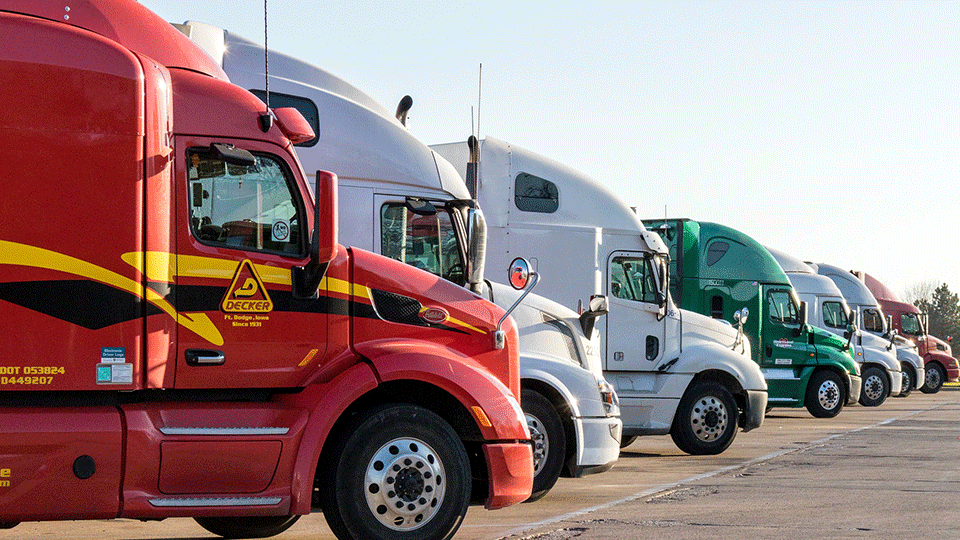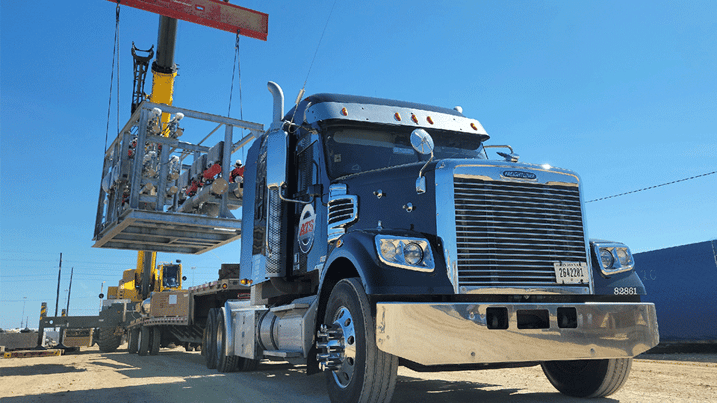
Assuming that a multi-truck project is priced in the same manner as a one-off shipment is one of the more common hangups logistics professionals encounter while sourcing project quotes.
Often, shippers figure that since securing one truck on a certain day costs $1,000 (for example) locking down five won’t change their per-truck rate. Logic tells them that this five-truck project will cost (using the same example) $5,000, or $1,000 per truck.
This makes sense. And, in a perfect world, this would be the case. However, project shipments that require a larger portion of area truck capacity each period (day, week, month), have a more intricate pricing model.
Usually, the more solutions a company needs, the more they should expect to pay for each one. Unfortunately, discounts for booking coverage in bulk don’t exist in the transportation industry.
Instead, as companies utilize greater portions of the overall market supply in an area — an area where the demand for those solutions remains the same — rates rise as the number of viable solutions shrinks.
This doesn’t mean that receiving effective and competitive rates for your next project is impossible. Nor are we suggesting that the price you pay is unpredictable or completely out of your control.
No, with the right expectations and planning, receiving accurate budgetary project quotes is manageable.
Anderson Trucking Service (ATS) is a transportation company that helps businesses across many industries move their project freight. For this reason, we can confidently offer advice on these loads, including which information you should provide and how to go about sourcing capacity.
In this article, we’ve listed seven keys to success when sourcing quotes for, and executing on, your next transportation project.
- Make sure to outline the scope of the project
- Thoroughly relay all specific cargo details
- Explain the loading capabilities at each location
- Receive budgetary quotes as far out as possible
- Field quotes from multiple providers
- Establish mutually agreed-to payment terms and understandings
- Avoid selecting providers based on price alone
1| Make Sure to Outline the Scope of the Project
Thoroughly understanding the scope of your project is foundational for accurately calculating your rates. Behind the scenes, transportation companies put a lot of thought into each quote they provide, considering even the most minute details when formulating them.
To churn out a rate that correctly reflects the cost of the service, your provider will need a well-rounded understanding of the task at hand. Although your carrier may request additional information, here is a list of the details you will want to invariably provide:
- The volume of trucks needed per period (day, week, month)
- Details on each lane your project will cover
- Timelines, deadlines and any appointment requirements
When these three pieces of information are communicated, pricing your project is far easier — increasing the likelihood that the rates you’re given properly reflect the cost of the service you need. Let’s talk a bit more about each of them.
The Volume (Number) of Trucks Needed Per Period (Day, Week, Month)
Every project is different. Some require 30 truckloads a week while others need far more. Your project’s volume considerations will play a large role in the price of executing it.
So, to accurately formulate projections for your freight expenses, it’s important that your transportation provider(s) understand these numbers. With this information, your carrier can begin the process of analyzing market trends in each of your pickup and delivery locations — testing inbound and outbound freight data around your target execution date.
Coupling the historical data at their disposal with their own understandings of your markets and your projected volumes allows your transportation provider to generate dependable daily, weekly and monthly pricepoint forecasts.
Correctly identifying the cost of securing large truck volumes, however, can not be done without first understanding the number of solutions necessary.

Details On Each Lane Your Project Will Cover
Lane-specific details are another central piece of your overall project scope. What is each shipment’s length of haul? Which state(s) will loads traverse? What origin and destination locations will be involved?
Supply and demand — two major factors driving freight rates — vary significantly between areas. As such, where your loads will be picked up and arrive influences the cost of arranging their transport. Additionally, should your freight require permits, escorts or any other ancillary safety service — the cost of which fluctuates by location — your route may need to be adjusted.
Related: 5 Common Problems With Permitted Project Loads (& How to Avoid Them)
Beyond where your shipment is traveling from, through or to, the distance each truck will cover also impacts the rates you’ll receive for your project.
Since truck drivers must follow hours of service (HOS) guidelines — which dictate the number of hours they're allowed to operate within a 24-hour period — the time your length of haul takes to complete (one way) is another factor providers must consider.
By and large, you can expect each truck driver to cover no more than 500-600 miles in a day. So, shipments that exceed this distance — or those that don’t allow drivers to be efficient with their time — typically have their prices adjusted to reflect the added commitment each driver must make.
Timelines, Deadlines and Appointment Requirements
Timeline information, complete with origin and destination appointment requirement details, is another fundamental piece of each transportation project.
Be sure to relay all relevant information to your provider so they can account for these requirements while formulating your freight rates.
This information should include:
- Target start date
- Estimated pickup time windows/appointments each day
- Estimated delivery time windows/appointments each day
- Projected completion date (final load delivered)
Using this information, your transportation company will plan accordingly; estimating the cost of securing consistent truck capacity in your area(s) that is capable of meeting your loading/unloading appointments.
2| Thoroughly Relay All Specific Cargo Details
Beyond the sheer scope of your project, it’s also important for each carrier you utilize to have a comfortable understanding of what they’ll be moving. Every commodity is different, requiring different considerations and tactics for moving them.
Some loads have sharp edges, necessitating strap savers and corner protectors.
Others have delicate components that are easily damaged during securement.
Others still are over-dimensional and non-divisible, leaving shippers no choice but to arrange permitting services.
It’s impossible to account for, and price in, this variance without knowing exactly what each product is. For this reason, in pursuit of accurate project quotes you’ll want to make sure that you communicate all pertinent cargo details on the front end.
This includes, but is not limited to:
- Specific cargo dimensions (height, weight, length and width)
- Make, model and serial number (where applicable)
- Cargo value (if over $100,000)
- Exact descriptions of each individual commodity
- Securement instructions and potentially sensitive areas on each piece
It is also helpful when photos are included at this stage of the quoting process. Since your provider likely won’t get hands-on with the cargo you need to have moved, seeing it visually helps to shorten this knowledge gap.
3| Explain The Loading Capabilities at Each Location
Projects usually require a substantial chunk of truck capacity to complete. Leaning on every possible option to secure this capacity is important. However, the options available to you, and your carrier, aren’t limitless.
And, without proper planning and communication, sometimes projects face delays when the wrong solution is booked or another falls through.

The onsite loading and offloading capabilities at each end of your project will directly impact the kinds of solutions your transportation company can send your way. For example, if side loading is the only option at your cargo’s origin, enclosed trailers (such as dry vans) will have to be avoided. Instead, flatbed, step-deck and other open-deck solutions will need to be arranged.
Imagine if your carrier didn’t understand this requirement when quoting your freight initially, though. Assuming dry van trailers are capable of meeting your needs when, in reality, they can’t could significantly impact your quotes.
You will want to make sure your transportation company understands the loading/offloading capabilities afforded to them. In turn, this will ensure your freight is priced as accurately as possible.
4| Receive Budgetary Quotes As Far Out As Possible
When receiving budgetary pricing for your projects (pricing which predicts what it should realistically cost to execute a set of shipments) it is always helpful to do so as early in the process as possible.
While you will want to ensure all of the information you provide (locations, cargo volumes, etc.) is as accurate as possible, don’t hesitate to request budgetary pricing as soon as these details are available.
This will help you budget for the expenses associated with moving cargoes and will allow your transportation company to test the market and begin the process of giving your definitive rates when the time comes.
Note, budgetary rates may not be exactly what you’ll pay when your project rolls around. Instead, you should expect these quotes to merely depict the projected cost of transportation services in your area at your time of execution. So it is also crucial to reconnect with your carrier(s) as the “go date” of each project approaches and lock in pricing at that time. Typically, this happens within 30-days of a project’s start.

5| Field Quotes From Multiple Providers
Regardless of whether it’s for a project or not, getting quotes from more than one transportation company is always recommended. At the very least, doing so will help you weigh prices against each other, identify outliers and make discernments as to which rates are accurate.
Consulting more than one provider will also allow you to ask questions about the quotes each has given you. Use these insights to better understand your pricing and exercise more cost control before locking into a long-term commitment.
It is also important to field quotes from both asset-based trucking companies and freight brokerages.
If an asset company is strong in the areas your project will frequent, they may be able to price it more competitively than a broker can. As such, be sure to source quotes from multiple provider types on your next project and select accordingly.
Related Content: Should I Use a Single Broker For Project Freight Shipping? 7 Key Advantages
6| Establish Mutually Agreed-To Payment Terms and Understandings
As your project kicks off, loading and unloading crews begin working and deadlines pass with rapid succession, it’s important that money (or the lack thereof) doesn’t slow things down.
Too often, projects stall because payments weren’t made on time or funding falls short.
Get on the same page with your provider(s) as to when payments will be made, how invoices should be managed, how frequently funds will arrive, etc.
 With proper planning, there’s no reason for your project to stop before completion. In fact, some transportation companies won’t hesitate to extend a line of credit to their customers to ensure everything stays on track.
With proper planning, there’s no reason for your project to stop before completion. In fact, some transportation companies won’t hesitate to extend a line of credit to their customers to ensure everything stays on track.
7| Avoid Selecting Providers Based on Price Alone
Your transportation provider selection decisions, although influenced by pricing, should never be made based solely on it. At the end of the day, trucking services cost what they cost. And, with so much on the line for your company, a project isn’t the time to cut corners or rely on the lowest cost provider — companies that can struggle to perform adequately.
Instead, you will be better served by selecting carriers based on a variety of additional criteria — price being one of them.
Among other things, ask each company about. . .
their history managing transportation projects, do they have an in-house team of experts to assist along the way?
their network and strengths in your area, do they have the resources needed to execute on their commitments?
the experience and expertise of the drivers they utilize.
their ability to stand by their pricing and provide credit assistance when necessary.
what they do to ensure on-time performance on time-sensitive loads.
The last thing you need is to choose a provider based on price alone that then struggles to uphold the commitments they’ve made. Effective project quotes are those backed by the experience, reliability and competency of a great provider.
Make sure each of your carriers has these qualities. Remember: someone can always do it cheaper.
What Else Should You Consider When Planning Your Next Project?
Though applying these seven tips is a great way to receive accurate and effective pricing for your next project, your research shouldn’t end here.
Sure, communicating your cargo and lane details, avoiding low-cost carriers and establishing concrete monetary understandings will set you up for success.
But your projects will still take plenty of additional planning and oversight.
Here is a list of best practices for ensuring success on any project. Your next step is to read them. In doing so, you’ll be better prepared to execute your upcoming projects, no matter what form they take.
Upon completion of that article, don’t hesitate to reach out with any questions you still have. And, if you’d like to learn more about how ATS can help you with your next project, check out our project logistics page for more information.




